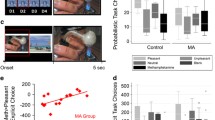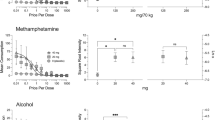Abstract
Rationale
Theoretical accounts highlight the importance of drug-related cues for the development and persistence of drug-taking behavior. Few studies have evaluated the ability of spatially contiguous drug cues to bias decisions between two concurrently presented non-drug reinforcers.
Objective
Evaluate the contribution of spatially contiguous cocaine cues to choice between two concurrently presented monetary reinforcers
Methods
Participants with cocaine use disorder completed a cued concurrent choice task. Two cues (one cocaine and one control image) were presented side-by-side followed by concurrent monetary offers below each image. Concurrent choice was measured for cocaine-side advantageous, equal, and disadvantageous concurrent monetary offers. The primary dependent measure was bias for selecting cocaine-cued monetary reinforcers. Three experiments tested selectivity of cocaine-cued bias in individuals with a cocaine use history (Experiment 1), replication when including additional control trials (Experiment 2), and a potential attentional mechanism evaluated using eye-tracking technology (Experiment 3).
Results
Significant and robust cocaine-cued bias at equal monetary value was observed in three experiments (mean percent choice = 65–77%) and higher Drug Abuse Screening Test (DAST) scores were associated with greater cocaine-choice bias. These experiments demonstrated that cocaine-cued bias was (1) selective to individuals with a cocaine use history, (2) specific to trials involving a cocaine cue, and (3) partially associated with attentional bias.
Conclusions
These experiments provide evidence that drug-related cues can influence choice and potentially promote maladaptive decision making during concurrent choice events. Future research evaluating prospective associations of drug-cued bias with drug-associated behaviors will help reveal the clinical relevance for substance use disorder.




Similar content being viewed by others
References
Armel KC, Beaumel A, Rangel A (2008) Biasing simple choices by manipulating relative visual attention. Judgm Decis Mak 3:396–403
Babor TF, Higgins-Biddle JC, Saunders JB, Monteiro MG, World Health Organization (2001) AUDIT: the alcohol use disorders identification test: guidelines for use in primary health care. World Health Organization, Geneva
Bruner NR, Johnson MW (2014) Demand curves for hypothetical cocaine in cocaine-dependent individuals. Psychopharmacol 231:889–897
Center for Behavioral Health Statistics (2017) Results from the 2016 National Survey on Drug Use and Health: Detailed tables. Subst Abus and Mental Health Services Administration, Rockville, MD
Chow JJ, Smith AP, Wilson AG, Zentall TR, Beckmann JS (2017) Suboptimal choice in rats: incentive salience attribution promotes maladaptive decision-making. Behav Brain Res 320:244–254
Fadardi JS, Cox WM, Rahmani A (2016) Neuroscience of attentional processes for addiction medicine: from brain mechanisms to practical considerations. Prog Brain Res 223:77–89
Field M, Cox WM (2008) Attentional bias in addictive behaviors: a review of its development, causes, and consequences. Drug Alcohol Depend 97:1–20
Franken IH, van de Wetering BJ (2015) Bridging the gap between the neurocognitive lab and the addiction clinic. Addict Behav 44:108–114
Hardy L, Hogarth L (2017) A novel concurrent pictorial choice model of mood-induced relapse in hazardous drinkers. Exp Clin Psychopharmacol 25:448–455
Hardy L, Mitchell C, Seabrooke T, Hogarth L (2017) Drug cue reactivity involves hierarchical instrumental learning: evidence from a biconditional Pavlovian to instrumental transfer task. Psychopharmacol 234:1977–1984
Heatherton TF, Kozlowski LT, Frecker RC, Fagerström KO (1991) The Fagerström test for nicotine dependence: a revision of the Fagerstrom Tolerance Questionnaire. Addiction 86:1119–1127
Hogarth L, Chase HW (2011) Parallel goal-directed and habitual control of human drug-seeking: implications for dependence vulnerability. J Exp Psychol Anim Behav Process 37:261–276
Hogarth L, Chase HW (2012) Evaluating psychological markers for human nicotine dependence: tobacco choice, extinction, and Pavlovian-to-instrumental transfer. Exp Clin Psychopharmacol 20:213–224
Hogarth L, Dickinson A, Duka T (2003) Discriminative stimuli that control instrumental tobacco-seeking by human smokers also command selective attention. Psychopharmacol 168:435–445
Hogarth L, Hardy L, Mathew AR, Hitsman B (2018) Negative mood-induced alcohol-seeking is greater in young adults who report depression symptoms, drinking to cope, and subjective reactivity. Exp Clin Psychopharmacol 26:138–146
Leeman RF, Robinson CD, Waters AJ, Sofuoglu M (2014) A critical review of the literature on attentional bias in cocaine use disorder and suggestions for future research. Exp Clin Psychopharmacol 22:469–483
MacKillop J, Brown CL, Stojek MK, Murphy CM, Sweet L, Niaura RS (2012) Behavioral economic analysis of withdrawal-and cue-elicited craving for tobacco: an initial investigation. Nicotine Tob Res 14:1426–1234
MacKillop J, O’Hagen S, Lisman SA, Murphy JG, Ray LA, Tidey JW, McGeary JE, Monti PM (2010) Behavioral economic analysis of cue-elicited craving for alcohol. Addiction 105:1599–1607
MacKillop J (2016) The behavioral economics and neuroeconomics of alcohol use disorders. Alcohol Clin Exp Res 40:672–685
Marks KR, Alcorn JL 3rd, Stoops WW, Rush CR (2016) Cigarette cue attentional bias in cocaine-smoking and non-cocaine-using cigarette smokers. Nicotine Tob Res 18:1915–1919
Marks KR, Pike E, Stoops WW, Rush CR (2014a) Test-retest reliability of eye tracking during the visual probe task in cocaine-using adults. Drug Alcohol Depend 145:235–237
Marks KR, Pike E, Stoops WW, Rush CR (2015) The magnitude of drug attentional bias is specific to substance use disorder. Psychol Addict Behav 29:690–695
Marks KR, Roberts W, Stoops WW, Pike E, Fillmore MT, Rush CR (2014b) Fixation time is a sensitive measure of cocaine cue attentional bias. Addiction 109:1501–1508
Mayo LM, de Wit H (2015) Acquisition of responses to a methamphetamine-associated cue in healthy humans: self-report, behavioral, and psychophysiological measures. Neuropsychopharmacology 40:1734–1741
Metrik J, Aston ER, Kahler CW, Rohsenow DJ, McGeary JE, Knopik VS, MacKillop J (2016) Cue-elicited increases in incentive salience for marijuana: craving, demand, and attentional bias. Drug Alcohol Depend 167:82–88
Miele A, Thompson M, Jao NC, Kalhan R, Leone F, Hogarth L, Hitsman B, Schnoll R (2018) Cancer patients enrolled in a smoking cessation clinical trial: characteristics and correlates of smoking rate and nicotine dependence. J Addict eCollection 2018
Moeller SJ, Beebe-Wang N, Woicik PA, Konova AB, Maloney T, Goldstein RZ (2013) Choice to view cocaine images predicts concurrent and prospective drug use in cocaine addiction. Drug Alcohol Depend 130:178–185
Moeller SJ, Maloney T, Parvaz MA, Alia-Klein N, Woicik PA, Telang F, Wang GJ, Volkow ND, Goldstein RZ (2010) Impaired insight in cocaine addiction: laboratory evidence and effects on cocaine-seeking behaviour. Brain 133:1484–1493
Moeller SJ, Maloney T, Parvaz MA, Dunning JP, Alia-Klein N, Woicik PA, Hajcak G, Telang F, Wang GJ, Volkow ND, Goldstein RZ (2009) Enhanced choice for viewing cocaine pictures in cocaine addiction. Biol Psychiatry 66:169–176
Moeller SJ, Stoops WW (2015) Cocaine choice procedures in animals, humans, and treatment-seekers: can we bridge the divide? Pharmacol Biochem Behav 138:133–141
Rescorla RA, Cunningham CL (1979) Spatial contiguity facilitates Pavlovian second-order conditioning. J Exp Psychol Anim Behav Process 5:152–161
Rose AK, Brown K, Field M, Hogarth L (2013) The contributions of value-based decision-making and attentional bias to alcohol-seeking following devaluation. Addiction 108:1241–1249
Rose AK, Brown K, MacKillop J, Field M, Hogarth L (2018) Alcohol devaluation has dissociable effects on distinct components of alcohol behaviour. Psychopharmacol 235:1233–1244
Skinner HA (1982) The drug abuse screening test. Addict Behav 7:363–371
Smith AP, Hofford RS, Zentall TR, Beckmann JS (2018) The role of ‘jackpot’ stimuli in maladaptive decision-making: dissociable effects of D1/D2 receptor agonists and antagonists. Psychopharmacol 235:1427–1437
Sofuoglu M, DeVito EE, Waters AJ, Carroll KM (2016) Cognitive function as a trans-diagnostic treatment target in stimulant use disorders. J Dual Diagn 12:90–106
Strickland JC, Stoops WW (2017) Stimulus selectivity of drug purchase tasks: a preliminary study evaluating alcohol and cigarette demand. Exp Clin Psychopharmacol 25:198–207
Wang GB, Zhang XL, Zhao LY, Sun LL, Wu P, Lu L, Shi J (2012) Drug-related cues exacerbate decision making and increase craving in heroin addicts at different abstinence times. Psychopharmacol 221:701–708
Zentall TR (2014) Suboptimal choice by pigeons: an analog of human gambling behavior. Behav Process 103:156–164
Acknowledgments
The authors gratefully acknowledge the staff of the University of Kentucky Laboratory of Human Behavioral Pharmacology for technical assistance.
Funding
The study received financial support from the National Institute on Drug Abuse of the National Institutes of Health (R21 DA035376; R01 DA036550) and the National Science Foundation (1247392). These funding agencies had no role in study design, data collection or analysis, or preparation and submission of the manuscript.
Author information
Authors and Affiliations
Corresponding author
Ethics declarations
The Institutional Review Board of the University of Kentucky approved all procedures. Participants provided written informed consent.
Conflict of interest
The authors declare that they have no conflicts of interest.
Disclaimer
The content is solely the responsibility of the authors and does not necessarily represent the official views of the National Institutes of Health or National Science Foundation.
Electronic supplementary material
ESM 1
(DOCX 894 kb)
Rights and permissions
About this article
Cite this article
Strickland, J.C., Marks, K.R., Beckmann, J.S. et al. Contribution of cocaine-related cues to concurrent monetary choice in humans. Psychopharmacology 235, 2871–2881 (2018). https://doi.org/10.1007/s00213-018-4978-5
Received:
Accepted:
Published:
Issue Date:
DOI: https://doi.org/10.1007/s00213-018-4978-5




